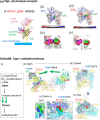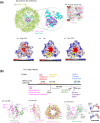Genome-wide association study of gastric cancer- and duodenal ulcer-derived Helicobacter pylori strains reveals discriminatory genetic variations and novel oncoprotein candidates
- PMID: 34846284
- PMCID: PMC8743543
- DOI: 10.1099/mgen.0.000680
Genome-wide association study of gastric cancer- and duodenal ulcer-derived Helicobacter pylori strains reveals discriminatory genetic variations and novel oncoprotein candidates
Abstract
Genome-wide association studies (GWASs) can reveal genetic variations associated with a phenotype in the absence of any hypothesis of candidate genes. The problem of false-positive sites linked with the responsible site might be bypassed in bacteria with a high homologous recombination rate, such as Helicobacter pylori, which causes gastric cancer. We conducted a small-sample GWAS (125 gastric cancer cases and 115 controls) followed by prediction of gastric cancer and control (duodenal ulcer) H. pylori strains. We identified 11 single nucleotide polymorphisms (eight amino acid changes) and three DNA motifs that, combined, allowed effective disease discrimination. They were often informative of the underlying molecular mechanisms, such as electric charge alteration at the ligand-binding pocket, alteration in subunit interaction, and mode-switching of DNA methylation. We also identified three novel virulence factors/oncoprotein candidates. These results provide both defined targets for further informatic and experimental analyses to gain insights into gastric cancer pathogenesis and a basis for identifying a set of biomarkers for distinguishing these H. pylori-related diseases.
Keywords: GWAS; Helicobacter pylori; duodenal ulcer; gastric cancer; population genomics; recombination.
Conflict of interest statement
The authors declare that there are no conflicts of interest.
Figures





References
Publication types
MeSH terms
Substances
LinkOut - more resources
Full Text Sources
Medical

